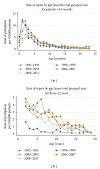Trends in the Rates of Pediatric Pyeloplasty for Ureteropelvic Junction Obstruction over 19 Years: A PHIS Database Study
- PMID: 24949008
- PMCID: PMC4052929
- DOI: 10.1155/2014/142625
Trends in the Rates of Pediatric Pyeloplasty for Ureteropelvic Junction Obstruction over 19 Years: A PHIS Database Study
Abstract
Background. Over the past 20 years, the management of ureteropelvic junction obstruction (UPJ) has shifted. While many urologists note a decrease in the number of pyeloplasties performed over time, the nature of the change in practice has yet to be defined. In the current study, we utilize a national, multi-institutional database of children's hospitals to evaluate trends in patients undergoing pyeloplasty as well as the rate of surgical reconstruction over the past 20 years. Material/Methods. We queried the Pediatric Health Information System (PHIS) database for all children undergoing primary pyeloplasty between 1992 and 2011. Clinical variables, including age at time of surgery, gender, length of stay (LOS), and geographic region, were determined. Age-adjusted rate of repair was also calculated per 100,000 PHIS inpatients. Results. 6,013 patients were included in the study, of which 71.6% were male and 64.2% were under the age of 24 months at time of surgery. Over the study period, the median age at time of surgery increased from 2-4 months to 12-14 months (P < 0.01). LOS decreased from a median of 5 days to 2 days (P < 0.001). The rate of surgery increased by 10.6 pyeloplasties per 100,000 PHIS inpatients from 1992 to 2011 (P < 0.01). The highest rate of pyeloplasty was in the northeast. The increase in pyeloplasties performed from 1992 to 1999 was specific to children aged greater than 24 months, while rates stayed the same in infants younger than 2 years during the same time period. In contrast, from 1999 to 2011, the rate of pyeloplasty decreased in patients less than 2 years of age, while the rate remained constant in patients over age 2. Conclusion. The rate of pyeloplasty increased in PHIS hospitals from 1992 to 2011. Trends are due to an increase in surgery in infants younger than 2 years from 1992 to 1999, followed by a progressive surgical rate decline, characterized by a shift towards patients older than 2 years of age.
Figures
Similar articles
-
Surgical management of congenital ureteropelvic junction obstruction: a Pediatric Health Information System database study.J Urol. 2008 Oct;180(4 Suppl):1689-92; discussion 1692. doi: 10.1016/j.juro.2008.03.096. Epub 2008 Aug 16. J Urol. 2008. PMID: 18708209
-
Cost Analysis of Treatments for Ureteropelvic Junction Obstruction.J Endourol. 2017 Feb;31(2):204-209. doi: 10.1089/end.2016.0722. Epub 2017 Jan 5. J Endourol. 2017. PMID: 27927021 Free PMC article.
-
Reoperative Laparoscopic Ureteropelvic Junction Obstruction Repair in Children: Safety and Efficacy of the Technique.J Urol. 2017 Mar;197(3 Pt 1):798-804. doi: 10.1016/j.juro.2016.10.062. Epub 2016 Oct 24. J Urol. 2017. PMID: 27789217
-
Pyeloplasty techniques using minimally invasive surgery (MIS) in pediatric patients.Transl Pediatr. 2016 Oct;5(4):251-255. doi: 10.21037/tp.2016.10.05. Transl Pediatr. 2016. PMID: 27867848 Free PMC article. Review.
-
Robot-assisted laparoscopic pyeloplasty: a review of minimally invasive treatment options for ureteropelvic junction obstruction.J Robot Surg. 2008;1(4):247-52. doi: 10.1007/s11701-007-0065-3. Epub 2008 Jan 8. J Robot Surg. 2008. PMID: 25484972 Free PMC article. Review.
Cited by
-
Inpatient interventions that may preclude outpatient open pyeloplasty in infants.Int Braz J Urol. 2019 Jan-Feb;45(1):145-149. doi: 10.1590/S1677-5538.IBJU.2018.0252. Int Braz J Urol. 2019. PMID: 30620155 Free PMC article.
-
Epidemiology of Infantile Ureteropelvic Junction Obstruction in the US.Urology. 2024 Jan;183:185-191. doi: 10.1016/j.urology.2023.09.024. Epub 2023 Oct 5. Urology. 2024. PMID: 37802192 Free PMC article.
-
Evolving trends in peri-operative management of pediatric ureteropelvic junction obstruction: working towards quicker recovery and day surgery pyeloplasty.World J Urol. 2021 Sep;39(9):3677-3684. doi: 10.1007/s00345-021-03621-9. Epub 2021 Mar 3. World J Urol. 2021. PMID: 33660089
-
Robotic Urologic Surgery in the Infant: a Review.Curr Urol Rep. 2019 May 18;20(7):35. doi: 10.1007/s11934-019-0902-8. Curr Urol Rep. 2019. PMID: 31104148 Review.
-
Hospital admission rates for pediatric multiple sclerosis in the United States using the Pediatric Health Information System (PHIS).Mult Scler Relat Disord. 2016 Sep;9:5-10. doi: 10.1016/j.msard.2016.05.018. Epub 2016 Jun 8. Mult Scler Relat Disord. 2016. PMID: 27645335 Free PMC article.
References
-
- Koyle MA, Ehrlich RM. Management of ureteropelvic junction obstruction in neonate. Urology. 1988;31(6):496–498. - PubMed
-
- Pocock RD, Witcombe JB, Andrews HS. The outcome of antenatally diagnosed urological abnormalities. British Journal of Urology. 1985;57(6):788–792. - PubMed
-
- Onen A, Jayanthi VR, Koff SA. Long-term followup of prenatally detected severe bilateral newborn hydronephrosis initially managed nonoperatively. Journal of Urology. 2002;168(3):1118–1120. - PubMed
-
- Koff SA. Neonatal management of unilateral hydronephrosis: Role for delayed intervention. Urologic Clinics of North America. 1998;25(2):181–186. - PubMed
-
- Ransley PG, Dhillon HK, Gordon I, Duffy PG, Dillon MJ, Barratt TM. The postnatal management of hydronephrosis diagnosed by prenatal ultrasound. Journal of Urology. 1990;144(2):584–587. - PubMed
LinkOut - more resources
Full Text Sources
Other Literature Sources
Miscellaneous






